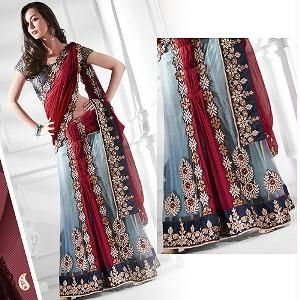Online Lehenga Shopping Definition
Source(Google.com.pk) wedding (Bengali: বিয়ে, বিবাহ) includes many rituals and ceremonies that can span several days.In most cases,it starts with the Aiburo Bhaat ceremony,and ends with the OSHTOMONGOLA(returning of the newly wed daughter to her parent's house,eight days after marriage) ceremony.Though the rituals differ with the varios districts of Bengal,usually it is classified into two: the Ghoti and Bangal rituals.[1][2]
Contents [hide]
1 Arranging the wedding
2 Dodhi Mongol
3 Turmeric ceremony
4 Wedding ceremony
5 Bou Bhaat
6 Phul Shojja
7 Oshto Mongola
8 Shubhochuni Satyanarayan Puja
9 New Trends
10 See also
11 References
Arranging the wedding [edit]
A traditional wedding is arranged by Ghotoks (matchmakers), who are generally friends,relatives of the couple,or sometimes even mere professionals. The matchmakers facilitate the introduction,and are given special gifts known as Ghotokbidae(bidding goodbye to the Ghotoks).
Bengali weddings are traditionally in four parts: the 'gaye holud, the wedding ceremony called Bibahobashor, and the reception known as Bou-bhaat. These take place on separate days. The first event in a wedding is Ashirvaad,where the elders of both families assemble to bless the bride and groom to-be with gifts of gold,silken clothes and dhan-durbo(husked rice and a special grass),signifying wealth,prosperity and well-being.The groom and bride may as well exchange rings,but this is not a part of the traditional Bengali wedding however.This marks the beginning of the elaborate wedding rituals.
A Bengali Hindu Marriage can be divided into the following parts:
Pre-wedding Rituals: Adan Pradan, Patri Patra, Ashirvad, Aai Buro Bhaat, Vridhi/Nanimukh, Dodhi Mangal, Holud Kota, Adhibas Tatva, Kubi Patta, Snan, Saankha Porano
Wedding Rituals: Bor Boron, Potto Bastra, Saat Paak, Mala Badal, Subho Drishti, Sampradan, Yagna, Saat Pak (couple), Anjali, Sindur Daan and Ghomta
Post-Wedding Rituals: Bashar Ghar, Bashi Biye(for the Bangal families), Bidaye, Bou Boron, Kaal Ratri, Bou Bhaat, Phool Sajja, Dwira Gaman
Dodhi Mongol [edit]
Before sunrise,both the bride and groom are fed a mixture of sweets,doi(curd)and khoi since they would be fasting the whole day until marriage.After this,women relatives of both families visit their nearby water-bodies,preferably the Ganga river to fetch water to be used for the rituals and also to invite Goddess Ganga to the wedding,and act as a witness.
Turmeric ceremony [edit]
Main article: Gaye Holud
Turmeric ceremony
It begins with the Nanimukh ceremony,when the eldest male member of the family pays tribute to the deceased male ancestors,through an elaborate puja,requesting their holy spirits to bless the couple to-be.This is followed by the turmeric ceremonies or gaye holud (Bengali: গায়ে হলুদ gaee holud, lit. "yellowing the body") take place before the wedding ceremony. There is one turmeric ceremony for the bride and one for the groom. For the bride's gaye holud, the groom's family - except the groom himself - go in procession to the bride's home. They carry with them the bride's wedding outfit, wedding decoration including turmeric paste(that has been touched to the groom's body), sweetmeats and gifts. They also take a large Rohu fish decorated as a bride. After the 'yellowing ceremony',the bride and groom are bathed by the water that the women had fetched from Ganga early that morning.There are local variations on this tradition, such as the number of fish, the party responsible for cooking the fish and time the fish is taken to the groom's family.
The procession traditionally centers on the female relative and friends of bride,and the paste is prepared by five married women called 'Eyo-stree',and they are traditionally all in matching clothes, mostly orange in colour.The bride is seated on a sheel-nora, and the women walk encircling her showering ganga waters upon her. The turmeric paste is applied by the bride's friends to her body. This is said to soften the skin, but also colours her with the distinctive yellow hue that gives its name to this ceremony. The sweets are then fed to the bride by all involved, piece by piece. There is, of course, a feast for the guests.Married women stain each other with the turmeric paste.
Wedding ceremony [edit]
A bride dressed in red sari
The wedding ceremony (Bengali: বিবাহ or বিয়ে bibaho/bie) follows the GAYE HOLUD ( means Turmeric is painted on the skin) ceremonies. The wedding ceremony is arranged by the bride's family. The groom, along with his friends and family (Borjatri), traditionally arrive later in the evening.The groom is sent a car from the bride's side and he rides the car with two elderly male relatives,one from the bride's side and another from his own family known as 'Borkorta',and the youngest male member from his family dressed as a groom,called 'Neet bor'. Before leaving for the wedding venue, the groom is blessed by his mother,and he formally seeks permission from her so as to start a new life with his would-be better-half.The groom's mother does not attend the wedding as it is believed to have negative impacts on her son's married life.Instead,she waits at home with some other ladies for her son and daughter-in-law ('Bouma').As the groom arrives,the older female relatives of the bride welcomes him with the auspicious sound of conch-shells and ululation.Then the bride's mother washes the wheel's of the groom's car with Ganga water,feeds him sweets and admires him through the 'Bor-boron' ceremony.The bride's family then gifts the groom with the wedding attire,which includes a 'jore'(silk shawl','dhoti' and 'topor',a head-dress made of pith and zari.The groom has to wear these clothes throughout the wedding rituals.It is also noteworthy that the wood required for the wedding yajna is brought by the groom's family,signifying the former's authoritative role over the entire ritual.There are purohits from both families and the wedding is conducted in the form of dialogue between them using Sanskrit mantras.While the groom participates in the main wedding ritual from the beginning,the bride joins it much later after she is brought by her brothers and friends,seated on a woodden seat called 'piri'.This symbolizes the medieval ideas of considering a daughter as a burden for the family,though nowadays its merely practised as a ritual and daughters are given equal affection as sons.This is followed by the 'Saat paak' when the bride encircles the groom seven times,still sitting on the 'piri' covering her face with beetel leaves.Then comes the Shubhodrishti,when thye bride finally puts down the leaves and their eyes meet.This is accompanied with heavy ululation and blowing of conch shells.The wedding is presided over by the bride's eldest male relative,who performs the konnasomprodaan.Finally comes the Sindurdaan,when the groom fills the bride's forehead/maangwith sindoor.It is then that they are considered socially married and one.After putting the sindoor,the bride's forehead is covered with a saree,called the 'lojja bostro',which is gifted by the groom himself.The 'mala boldol' or exchanging of garlands gives the wedding(seven times encircling the yajna fire or Agni dev,the Fire God.)The loose ends of the bride and groom's dresses are tied in a knot called 'jor bandha' or 'gat bandhan',and this is done by the groom's sister,whilst,the bride's brother assists the couple in offering anjali of 'khoi' to the Fire God.A grand feast is carried out called 'Preetibhoj'.After all these,the couple sits side-by-side and cannot open the knot by which they have been tied together.It is followed by the bashorghor which is an informal and friendly interaction between younger relatives and friends from both sides,and it continues throughout the night.The elders usually stay away from this event.Basor Raat starts after midnight if the wedding ceremony is over by evening. Most Hindu Bengali marriages are held during evening.
The next morning, preferably before noon, the couple make their way from the venue to the groom's home for the Ghotis,though for Bangals,a "Bashi Biya" or "Chaturtha-mangal" is held and the couple leaves for the groom's house after evening. This is known as the vidaai ceremony,and the bride makes an offering of rice "Kanakanjali" to her mother,thereby clearing all the debts that she had incurred during her years at her paternal home—although "Kanakanjali" is not held in every Bengali marriage. While it symbolizes the end of celebrations for the bride's family,it marks the beginning of the second phase of celebrations to be organized by the groom's family. On reaching home,the couple is welcomed by the groom's mother and all other members,in a ritual called 'Bouboron'.Then the elders make gifts of gold to the bride. The bride is then asked to walk with her feet dipped in aalta on a sari,and her footprints are regarded as those of Lakshmi entering the groom's house. She is then shownthe kitchen, store-room and all other things signifying prosperity,wealth and happiness of her new family. Its also the day known a "Kaalratri",and so the bride and groom are not allowed to even see each other, as Kaalratri was the very night when Behula's husband was bitten by a serpent, as stated in the Manasamangal Kavya.
Bou Bhaat [edit]
The following day,i.e.,the second day of the bride at her new home is celebrated as Bou Bhaat as on this day,she serves Rice with Ghee to all her in-laws at lunch.The evening is celebrated as a reception party,where all the distant relatives along with the close ones from the groom's side are invited and introduced to the bride.The bride's family members 'Konyajatri' also attend the reception with 'tatwo'(gtifts of clothes,sweetmeats,jewellery,and all other essentials for the bride and her in-laws).A grand feast is carried out called 'Preetibhoj'.
Phul Shojja [edit]
Flower bed.
In the flower bed ceremony (Bengali: ফুল শয্যা ful shôjja, lit. "flower bed"), the bride wears a lot of floral ornaments presented by the bride's family, and their marriage bed is decorated with flowers by the groom's family. This is the night of consummation.
Oshto Mongola [edit]
Eight days after marriage, the couple visits the bride's house and spends three nights there. It is accompanied by relentless feasting, and opening of the 'Gatbandhan' that had been tied on their day of marriage.
Among the Bengali Hindus of Sylheti origin, this ritual is known as "Fira-jatra".
Shubhochuni Satyanarayan Puja [edit]
On the eighth day of marriage, a Satyanarayan puja is conducted by the groom's family, in which the newly wed couple, in their wedding attires, are blessed by the purohit and prayers are offered to bless the couple with a happy family. The couple then leaves for Oshtomongola.
Online Lehenga Shopping Image Photo Pictures 2013

Online Lehenga Shopping Image Photo Pictures 2013

Online Lehenga Shopping Image Photo Pictures 2013

Online Lehenga Shopping Image Photo Pictures 2013

Online Lehenga Shopping Image Photo Pictures 2013

Online Lehenga Shopping Image Photo Pictures 2013

Online Lehenga Shopping Image Photo Pictures 2013

Online Lehenga Shopping Image Photo Pictures 2013

Online Lehenga Shopping Image Photo Pictures 2013

Online Lehenga Shopping Image Photo Pictures 2013
Online Lehenga Shopping Image Photo Pictures 2013
Online Lehenga Shopping Image Photo Pictures 2013
Online Lehenga Shopping Image Photo Pictures 2013

No comments:
Post a Comment